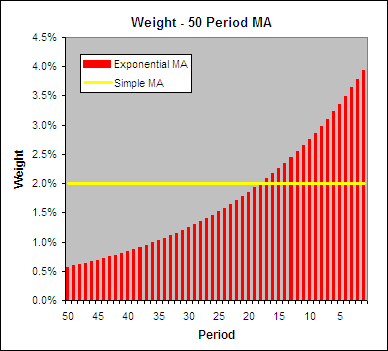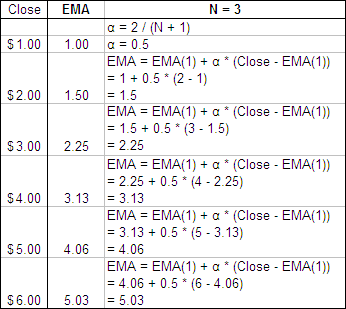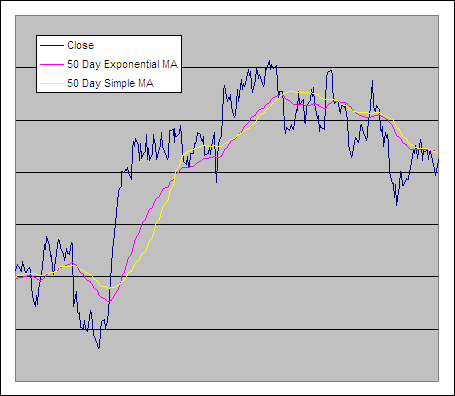The Exponential Moving Average (EMA) is a very popular method for smoothing data in an attempt to eliminate noise and our tests show that it is also highly effective. Unlike the Simple Moving Average (SMA) that applies equal weight to all data, the EMA applies more weight to the recent data so that it reacts faster to sudden changes.
You can see see why it is called an Exponential Moving Average when you look at how the weighting is applied; it is in the shape of an exponential curve. Because of this the weighting never reaches zero and the influence of early data always remains (although it has little effect outside of the specified smoothing period). This is more clearly illustrated by the chart below which shows the weighting for a 50 period EMA and a SMA:
.
 .
.
Although we call it a 50 period EMA, those 50 periods only actually account for 86% of the weighting. A further 12% is applied over the preceding 50 periods leaving the last 2% to be spread amongst all the prior data. Here is a great article from MarketSci on this topic: Visual Depiction of SMA vs EMA Weighting
.
How To Calculate an Exponential Moving Average
.
Calculating an Exponential Moving Average actually requires less processing power than a Simple Moving Average because it only refers to the current period and the previous EMA value. While it does not become active until the Nth period the EMA starts with the first close price and after that is calculated according to the following formula:
EMA = EMA(1) + α * (Close – EMA(1))
Where:
α = 2 / (N + 1)
N = The smoothing period.
Here is an example of a 3 period Exponential Moving Average:
.

If you have two data sets and you wish to find out the EMA smoothing period, the following formula will reveal it:
N = (2-( (MA-MA[1]) / (Close-MA[1]) ) ) / ( (MA-MA[1]) / (Close-MA[1]) )
.
Exponential Moving Average Excel File
.
The EMA is so simple to calculate that it is unlikely that you would need a version in Excel but we have put together one for those of you that are lazy :). It is free and contains the ‘basic’ version you can see above and one that will automatically adjust to the length you specify. Find it at the following link near the bottom of the page under Downloads – Technical Indicators: Exponential Moving Average (EMA).
.
Exponential Moving Average and a Simple Moving Average
.
 .
.
Test Results
.
If you haven’t already then check out the EMA test results. We tested it against the SMA and D-EMA through 300 years of data across 16 global markets to reveal which is the best and the characteristics they exhibit as their smoothing period is changed. See the results; Moving Averages – Simple vs Exponential
.